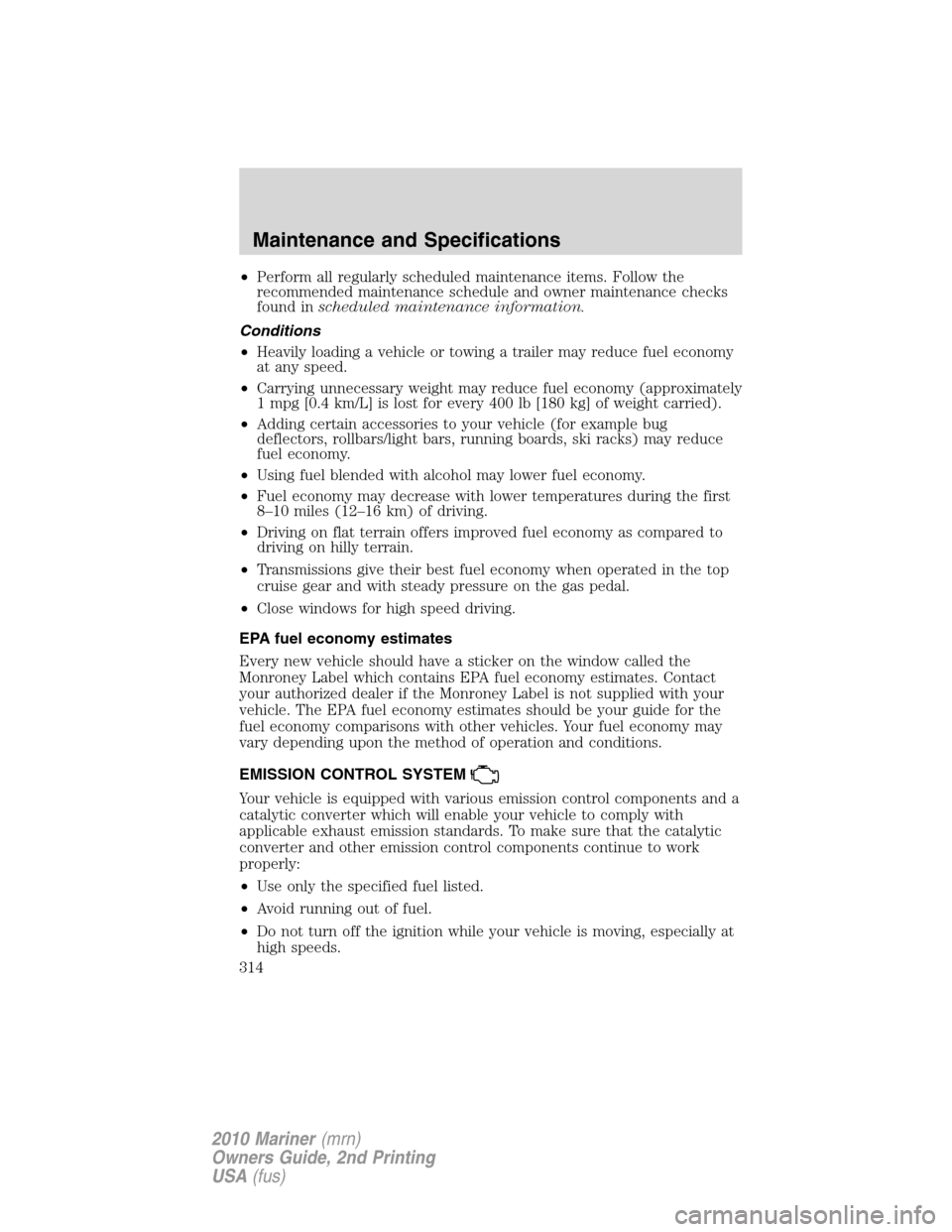Page 220 of 339

AdvanceTrac�with RSC�Features
Button
functions“Sliding
car”
icon
RSC�ESCTraction
Control
Default at
start-upIlluminated
during bulb
checkEnabled Enabled Enabled
Button pressed
momentarilyIlluminated
solidEnabled Enabled Disabled
Button pressed
again after
deactivationNot
illuminatedEnabled Enabled Enabled
Trailer sway control (if equipped)
Your vehicle may be equipped with trailer sway control (TSC). When
properly equipped, trailer sway control will use the sensors of the
vehicle’s AdvanceTrac�with RSC�system to detect and attempt to
mitigate trailer sway by applying brake force at individual wheels and, if
necessary, by reducing engine power. No driver action is required.
WARNING:Trailer sway control does not prevent a trailer from
swaying, it mitigates the sway from increasing once it has
occurred. TSC cannot stop all trailers from swaying. If you are
experiencing trailer sway, it is likely that the trailer is improperly
loaded for the correct tongue weight or the speed of the vehicle and
trailer is too high. Pull the vehicle-trailer over to a safe location to
check the trailer weight distribution and tongue load and reduce speed
to a safe level while towing. If trailer sway is experienced, SLOW
DOWN. Always use caution when towing a trailer and follow the
tongue weight recommendations. Refer to theTrailer towingsection
in theTires Wheels and Loadingchapter of this owner’s guide for
more information on towing a trailer with your vehicle.
During trailer sway control events the
icon in the instrument cluster
will flash momentarily. In some cases when trailer sway is detected, the
vehicle speed is too high and may be at or above a speed at which trailer
sway will grow continuously. This may cause the system to activate
multiple times, and you may experience a slight deceleration of the
vehicle.
Driving
220
2010 Mariner(mrn)
Owners Guide, 2nd Printing
USA(fus)
Page 314 of 339

•Perform all regularly scheduled maintenance items. Follow the
recommended maintenance schedule and owner maintenance checks
found inscheduled maintenance information.
Conditions
•Heavily loading a vehicle or towing a trailer may reduce fuel economy
at any speed.
•Carrying unnecessary weight may reduce fuel economy (approximately
1 mpg [0.4 km/L] is lost for every 400 lb [180 kg] of weight carried).
•Adding certain accessories to your vehicle (for example bug
deflectors, rollbars/light bars, running boards, ski racks) may reduce
fuel economy.
•Using fuel blended with alcohol may lower fuel economy.
•Fuel economy may decrease with lower temperatures during the first
8–10 miles (12–16 km) of driving.
•Driving on flat terrain offers improved fuel economy as compared to
driving on hilly terrain.
•Transmissions give their best fuel economy when operated in the top
cruise gear and with steady pressure on the gas pedal.
•Close windows for high speed driving.
EPA fuel economy estimates
Every new vehicle should have a sticker on the window called the
Monroney Label which contains EPA fuel economy estimates. Contact
your authorized dealer if the Monroney Label is not supplied with your
vehicle. The EPA fuel economy estimates should be your guide for the
fuel economy comparisons with other vehicles. Your fuel economy may
vary depending upon the method of operation and conditions.
EMISSION CONTROL SYSTEM
Your vehicle is equipped with various emission control components and a
catalytic converter which will enable your vehicle to comply with
applicable exhaust emission standards. To make sure that the catalytic
converter and other emission control components continue to work
properly:
•Use only the specified fuel listed.
•Avoid running out of fuel.
•Do not turn off the ignition while your vehicle is moving, especially at
high speeds.
Maintenance and Specifications
314
2010 Mariner(mrn)
Owners Guide, 2nd Printing
USA(fus)
Page 328 of 339
The Vehicle Identification Number (VIN) contains the following
information:
1. World manufacturer identifier
2. Brake system / Gross Vehicle
Weight Rating (GVWR) / Restraint
Devices and their location
3. Make, vehicle line, series, body
type
4. Engine type
5. Check digit
6. Model year
7. Assembly plant
8. Production sequence number
TRANSMISSION CODE DESIGNATIONS
You can find a transmission code on
the Safety Compliance Certification
Label. The following table tells you
which transmission each code
represents.
Description Code
Six-speed automatic 6
Maintenance and Specifications
328
2010 Mariner(mrn)
Owners Guide, 2nd Printing
USA(fus)
Page 330 of 339

Peace of mind
Remote start system
Vehicle security system
Wheel locks
For maximum vehicle performance, keep the following information in
mind when adding accessories or equipment to your vehicle:
•When adding accessories, equipment, passengers and luggage to your
vehicle, do not exceed the total weight capacity of the vehicle or of
the front or rear axle (GVWR or GAWR as indicated on the Safety
Compliance Certification label). Consult your authorized dealer for
specific weight information.
•The Federal Communications Commission (FCC) and Canadian Radio
Telecommunications Commission (CRTC) regulate the use of mobile
communications systems — such as two-way radios, telephones and
theft alarms - that are equipped with radio transmitters. Any such
equipment installed in your vehicle should comply with FCC or CRTC
regulations and should be installed only by a qualified service
technician.
•Mobile communications systems may harm the operation of your
vehicle, particularly if they are not properly designed for automotive
use.
•To avoid interference with other vehicle functions, such as anti-lock
braking systems, amateur radio users who install radios and antennas
onto their vehicle should not locate the Amateur Radio Antennas in
the area of the driver’s side hood.
•Electrical or electronic accessories or components that are added to
the vehicle by the authorized dealer or the owner may adversely affect
battery performance and durability.
Accessories
330
2010 Mariner(mrn)
Owners Guide, 2nd Printing
USA(fus)